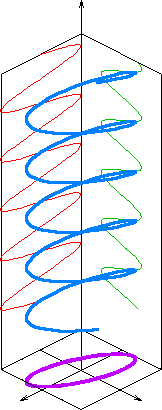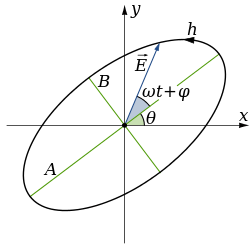Elliptical polarization
In electrodynamics, elliptical polarization is the polarization of electromagnetic radiation such that the tip of the electric field vector describes an ellipse in any fixed plane intersecting, and normal to, the direction of propagation. An elliptically polarized wave may be resolved into two linearly polarized waves in phase quadrature, with their polarization planes at right angles to each other. Since the electric field can rotate clockwise or counterclockwise as it propagates, elliptically polarized waves exhibit chirality.
Other forms of polarization, such as circular and linear polarization, can be considered to be special cases of elliptical polarization.

Mathematical description of elliptical polarization
The classical sinusoidal plane wave solution of the electromagnetic wave equation for the electric and magnetic fields is (cgs units)
for the magnetic field, where k is the wavenumber,
is the angular frequency of the wave propagating in the +z direction, and is the speed of light.
Here is the amplitude of the field and
is the normalized Jones vector. This is the most complete representation of polarized electromagnetic radiation and corresponds in general to elliptical polarization.
Polarization ellipse

At a fixed point in space (or for fixed z), the electric vector traces out an ellipse in the x-y plane. The semi-major and semi-minor axes of the ellipse have lengths A and B, respectively, that are given by
and
- ,
where . The orientation of the ellipse is given by the angle the semi-major axis makes with the x-axis. This angle can be calculated from
- .
If , the wave is linearly polarized. The ellipse collapses to a straight line ) oriented at an angle . This is the case of superposition of two simple harmonic motions (in phase), one in the x direction with an amplitude , and the other in the y direction with an amplitude . When increases from zero, i.e., assumes positive values, the line evolves into an ellipse that is being traced out in the counterclockwise direction (looking in the direction of the propagating wave); this then corresponds to left-handed elliptical polarization; the semi-major axis is now oriented at an angle . Similarly, if becomes negative from zero, the line evolves into an ellipse that is being traced out in the clockwise direction; this corresponds to right-handed elliptical polarization.
If and , , i.e.,the wave is circularly polarized. When , the wave is left-circularly polarized, and when , the wave is right-circularly polarized.
See also
References
 This article incorporates public domain material from the General Services Administration document "Federal Standard 1037C" (in support of MIL-STD-188).
This article incorporates public domain material from the General Services Administration document "Federal Standard 1037C" (in support of MIL-STD-188).
External links
- Animation of Elliptical Polarization (on YouTube)
- Comparison of Elliptical Polarization with Linear and Circular Polarizations (YouTube Animation)